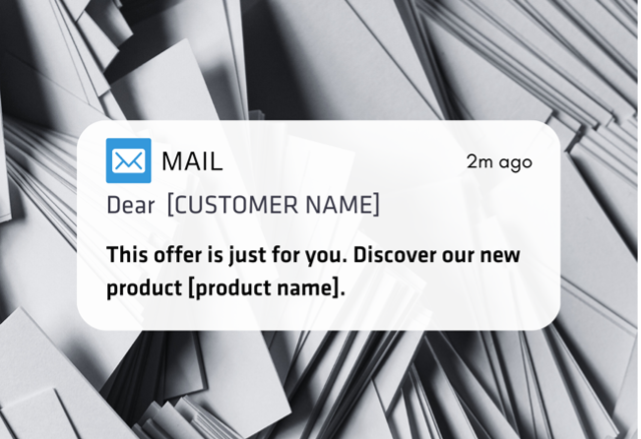"In the end, what makes life easier for the customer will prevail."
What happens in the B2B Sector What started in the B2C sector has long since been transferred to the B2B sector: Providing customers with smooth, convenient and easy access to your products and services is THE way to stay relevant and competitive in the long term. As a result, B2B e-commerce has seen a major shift in the way companies interact with their customers.
Data-driven strategies based on personalization play a critical role.
But personalization in B2B e-commerce goes far beyond simply addressing customers by name.
It is about understanding customer behavior and preferences and offering relevant information, products or services to the right customer, at the right time and place, and ideally at the right price. anzubieten.
But this is easier said than done.

After all, it is far from the case that data about customers is not available in the company. In fact, there are often very large amounts of data that have been collected and stored for years in the systems used. The real problem is that they are not being used and are literally gathering dust in the system. Not because there is no use for them, but because they are simply not usable in their current form. Scattered across systems, in the minds of employees, or in offline sources, the data is simply not accessible for sales or marketing to truly work with.
Although data-driven sales strategies are a key element of the modern sales process, sales decisions are still not sufficiently data-driven. In many organizations, sales decisions are made "on instinct," based on experience or personal preference, rather than on sound analysis of relevant data. This leads to potential risks such as ineffective sales strategies, inaccurate revenue forecasts, and suboptimal resource allocation.
"There are big data treasures in companies that are simply not being mined."
But how can companies untangle this knot and make existing customer data work for them?
This is where well-designed, holistic networking of information comes into play. Such networking prevents data silos in the enterprise - collections of data in different systems that do not "talk" to each other, but remain unused as a "silo" with no connection to other "silos".
In the meantime, Big Data and analysis tools such as Power BI, CRM systems of all kinds have given us the opportunity to accomplish this very networking. For this purpose, the data is matched and connected in a data mapping, enriched and supplemented in opposite directions. This networking enables a holistic view of the data and thus a comprehensive view of the customer himself. It may sound wrong, but this is how companies achieve the goal of creating a "transparent customer.
Mapping and linking the data later enables the next step: analysis to draw conclusions about buying behavior and customer lifecycle patterns.
Rule sets can then be used to infer individual customers from the masses. With this insight, it becomes possible to develop targeted data-based and customer-oriented strategies for marketing and sales.
Data-driven sales strategies enable companies to optimize the sales process and make effective sales decisions based on facts. By analyzing customer, sales, market, and competitive data, companies can gain valuable insights to improve their sales strategies.
A special plus: Data-driven sales decisions can also help to personalize the sales process,, better understand customer needs and and plan targeted marketing and sales activities. Companies should increasingly rely on data-driven sales strategies to improve their sales performance and succeed in today's competitive market.
Some key aspects of how data-driven strategies are shaping B2B sales and customer relationships include
- Customer-specific recommendations, offers and prices: By analyzing customer data such as purchase behavior, order history and preferences, B2B companies can pursue data-driven strategies. Based on this, recommendations, offers and prices are tailored to the individual customer.
- Improved customer experience: Personalization in B2B e-commerce enables companies to offer their customers a seamless and personalized buying experience. This enables companies to deliver personalized content, recommendations, and offers across multiple channels, including websites, email, and mobile applications.
- Strengthening customer relationships: Data-driven personalization enables B2B companies to understand and respond to their customers' needs and preferences. This allows companies to build long-term customer loyalty and motivate customers to make repeat purchases and form long-term partnerships.
Conclusion
Using data to create tailored offers and experiences for B2B customers has become a powerful tool for empowering sales, shaping customer relationships, and taking B2B sales to the next level of personalization. B2B zu heben.
An example/use case: Optimizing B2B sales through data-driven personalization in e-commerce
ProDynamics AG, a company that manufactures and sells industrial machinery to B2B customers, realized it needed to improve its sales strategies to succeed in a competitive market. It has large amounts of customer data that has been stored in different systems over the years, but this data has been unusable due to data silos and lack of connectivity. ProDynamics has adopted a data-driven personalization strategy for B2B e-commerce to improve sales performance and strengthen customer relationships. They go through the following steps:
Step 1: Data networking and data mapping
ProDynamics implements big data and analytics tools such as Power BI to connect and align existing customer data in a data mapping. Data is aggregated from a variety of sources, including customer databases, CRM systems, sales data, and market and competitive data. This networking gives the company a holistic overview of its customers and a better understanding of their needs and preferences.
Step 2: Data analysis and derivation of findings
Next, the company analyzes the connected customer data and derives valuable insights. It identifies patterns in customer behavior, such as preferred product categories, buying cycles, budgets, and decision-making processes. Rule sets are used to infer from the crowd to the individual customer to create individual customer profiles and develop personalized strategies.
Step 3: Personalized sales strategies
Based on the insights gained, ProDynamics develops personalized sales strategies for each customer. It tailors its marketing and sales activities to the needs and preferences of its customers. For example, the company uses personalized e-mail campaigns, tailored offers, and individual product recommendations to capture customer interest and support the sales process. It also uses data-driven sales decisions to optimize sales processes, deploy resources more effectively, and forecast sales more accurately.
Step 4: Improved customer relations
The company's personalized sales strategies significantly improve customer relationships. Customers feel better understood and valued because ProDynamics listens to their individual needs and offers customized solutions. Customers are more likely to repurchase and build long-term relationships.
____________
Through data-driven personalization in B2B e-commerce, ProDynamics is strengthening customer loyalty and measurably increasing sales. Sales are thus optimized and customers receive the offer that really suits their needs.
Find more information: Customer Master Data Solutions in Cross-Channel Retail at Ernsting's Family GmbH & Co. KG
You can also read: möbelfertigung. When B2B must become B2C
or
Get in touch with us to orchestrate your individual situation. We will be happy to share exciting insights into industry-specific features and best practices and provide you with individual recommendations for your company.
